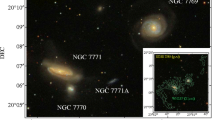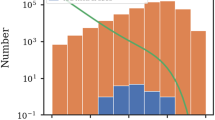Abstract
We present the results of our analysis of the geometrical tidal tail characteristics for nearby and distant interacting galaxies. The sample includes more than two hundred nearby galaxies and about seven hundred distant ones. The distant galaxies have been selected in several deep fields of the Hubble Space Telescope (HDF-N, HDF-S, HUDF, GOODS, GEMS) and they are at mean redshift 〈z〉 = 0.65. We analyze the distributions of lengths and thicknesses for the tidal structures and show that the tails in distant galaxies appear shorter than those in nearby ones. This effect can be partly attributed to observational selection, but, on the other hand, it may result from the general evolution of the sizes of spiral galaxies with z. The positions of interacting galaxies on the galaxy luminosity (L)-tidal tail length (l) plane are shown to be explained by a simple geometrical model, with the upper envelope of the observed distribution being \(l \propto \sqrt L\). We have solved the problem on the relationship between the observed distribution of tail flatting and the tail length in angular measure by assuming the tidal tails to be arcs of circumferences visible at arbitrary angles to the line of sight. We conclude that the angular length of the tidal tails visually distinguished in nearby and distant galaxies, on average, exceeds 180°.
Similar content being viewed by others
References
T. A. Agekyan, Probability Theory for Astronomers and Physicists (Nauka, Moscow, 1974) [in Russian].
I. Balestra, V. Mainieri, P. Popesso, et al., Astron. Astrophys. 512, 12 (2010).
J. Barnes and L. Hernquist, Nature 360, 715 (1992).
C. R. Bridge, R. G. Carlberg, and M. Sullivan, Astrophys. J. 709, 1067 (2010).
D. Coe, N. Benitez, S. F. Sanchez, et al., Astron. J. 132, 926 (2006).
J. Dubinski, J. Ch. Mihos, and L. Hernquist, Astrophys. J. 462, 576 (1996).
J. Dubinski, J. Ch. Mihos, and L. Hernquist, Astrophys. J. 526, 607 (1999).
P.-A. Duc, arXiv:1101.4834v2 (2011).
A. A. Dutton, F. C. van den Bosch, S. M. Faber, et al., Mon. Not. R. Astron. Soc. 410, 1660 (2011).
B. G. Elmegreen, M. Kaufman, and M. Thomasson, Astrophys. J. 412, 90 (1993).
D. M. Elmegreen, B. G. Elmegreen, Th. Ferguson, and B. Mullan, Astrophys. J. 663, 734 (2007).
A. Fernandez-Soto, K. M. Lanzetta, and A. Yahil, Astrophys. J. 513, 34 (1999).
K. Glazebrook, A. Verma, B. Boyle, et al., Astron. J. 131, 2383 (2006).
I. D. Karachentsev, Binary Galaxies (Nauka, Moscow, 1987) [in Russian].
J. Ch. Mihos, Astrophys. J. 438, L75 (1995).
J. Ch. Mihos, J. Dubinski, and L. Hernquist, Astrophys. J. 494, 183 (1998).
Ya. Kh. Mokhamed and V. P. Reshetnikov, Astrofizika 54, 181 (2011).
P. B. Nair and R. G. Abraham, Astrophys. J. Suppl. Ser. 186, 427 (2010).
V. P. Reshetnikov, Astron. Lett. 24, 153 (1998).
V. P. Reshetnikov, Astron. Astrophys. 353, 92 (2000).
V. P. Reshetnikov and N. Ya. Sotnikova, Astron. Astrophys. Trans. 20, 111 (2001).
M. Sawicki and G. Mallen-Ornelas, Astron. J. 126, 1208 (2003).
J. M. Schombert, J. F. Wallin, and C. Struck-Marcell, Astron. J. 99, 497 (1990).
N. Ya. Sotnikova and V. P. Reshetnikov, Izv. RAN 62, 1757 (1998a).
N. Ya. Sotnikova and V. P. Reshetnikov, Astron. Lett. 24, 73 (1998b).
V. Springel and S. D. M. White, Mon. Not. R. Astron. Soc. 307, 162 (1999).
A. Toomre and J. Toomre, Astrophys. J. 178, 623 (1972).
R. E. Williams, S. Baum, L. E. Bergeron, et al., Astron. J. 120, 2735 (2000).
C. Wolf, K. Meisenheimer, M. Kleinheinrich, et al., Astron. Astrophys. 421, 913 (2004).
Author information
Authors and Affiliations
Corresponding author
Additional information
Original Russian Text © Y.H. Mohamed, V.P. Reshetnikov, N.Ya. Sotnikova, 2011, published in Pis’ma v Astronomicheskiĭ Zhurnal, 2011, Vol. 37, No. 10, pp. 730–739.
Rights and permissions
About this article
Cite this article
Mohamed, Y.H., Reshetnikov, V.P. & Sotnikova, N.Y. On the characteristics of tidal structures of interacting galaxies. Astron. Lett. 37, 670–678 (2011). https://doi.org/10.1134/S1063773711100045
Received:
Published:
Issue Date:
DOI: https://doi.org/10.1134/S1063773711100045




